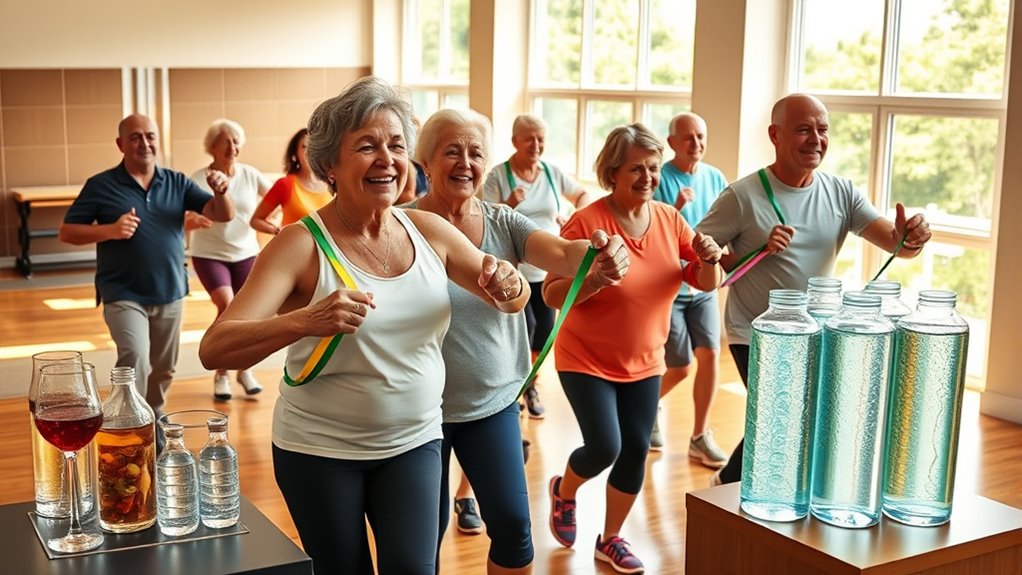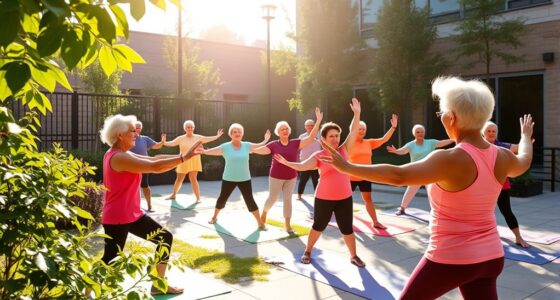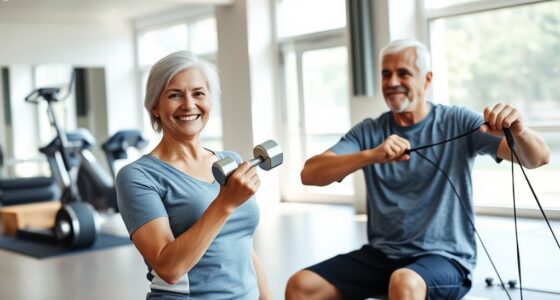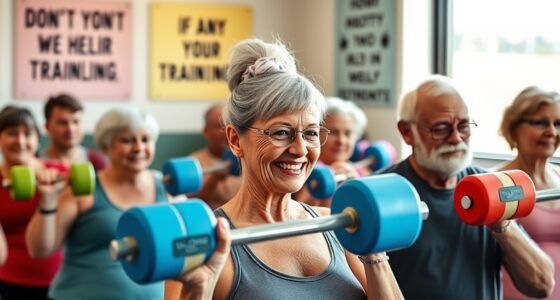Cardio workouts are essential for seniors like you, boosting heart health and enhancing overall well-being. Engaging in activities such as walking, swimming, and group exercise can elevate your heart rate and improve endurance. Don’t forget to warm up properly to reduce injury risk and always hydrate before, during, and after your workouts. Strength training complements cardio by enhancing mobility and bone density. Want to discover more tips to keep active and motivated?
Key Takeaways
- Engage in at least 150 minutes of moderate-intensity cardio weekly to reduce heart disease risk and maintain a healthy weight.
- Incorporate low-impact activities like walking, swimming, and chair exercises for effective cardiovascular benefits without straining joints.
- Utilize group exercise classes for motivation, social interaction, and enhanced enjoyment during cardio workouts.
- Complement cardio with proper warm-up and recovery techniques, including hydration and gentle stretching, to prevent injuries and aid recovery.
- Track your progress with a workout journal or fitness app to stay motivated and celebrate milestones in your cardio journey.
The Importance of Cardio for Seniors
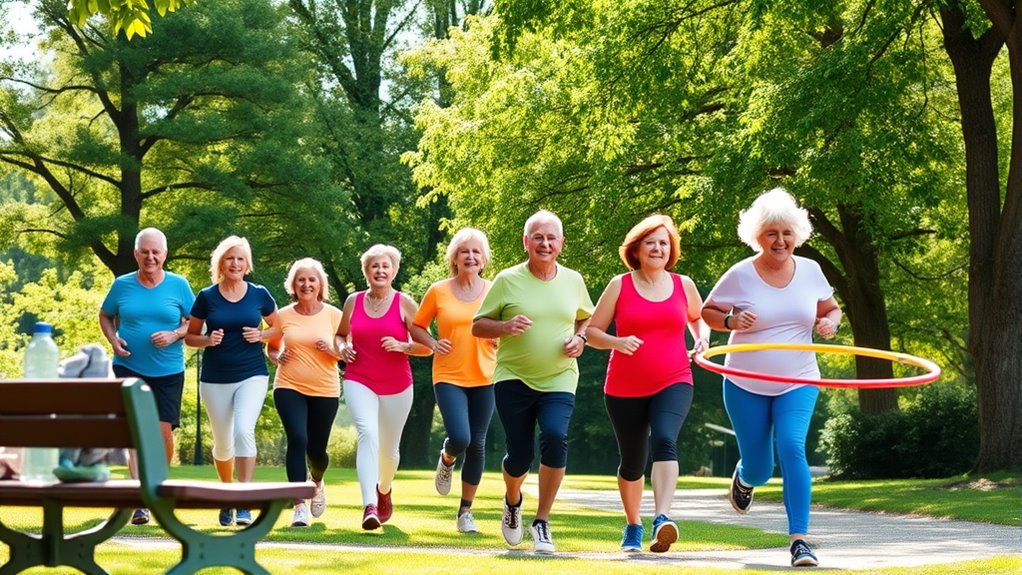
As you age, staying active becomes even more vital, and cardio workouts play an important role in maintaining your health.
Regular cardio exercise can considerably reduce the risk of heart disease, stroke, and high blood pressure, promoting overall cardiovascular health. Aim for at least 150 minutes of moderate-intensity cardio each week to help maintain a healthy weight and boost metabolism. Incorporating smart home technologies can also create a safer and more supportive environment for your workouts. Additionally, using air purifiers with HEPA filters can help ensure cleaner air during your exercise sessions, enhancing respiratory function. Engaging in regular physical activity not only improves your heart health but also supports overall wellness and vitality as you age. Research-backed articles often highlight the vital role of exercise in preventing age-related health issues.
You’ll also enhance your lung capacity and oxygen utilization, which are essential for sustaining energy and independence in daily life. Plus, engaging in these activities can improve your mental health by reducing anxiety and depression symptoms. Additionally, incorporating air purification systems can further enhance your indoor air quality, supporting better respiratory health during your workouts.
Warm-Up Exercises to Get Started

Getting your body ready for a cardio workout is just as important as the workout itself. A proper warm-up increases your heart rate and prepares your muscles, reducing injury risk. Engaging in a warm-up routine not only enhances your performance but also fosters creative practice that can lead to better overall health. Additionally, understanding financial considerations for elderly care can help you plan for long-term health and wellness. Incorporating exercises that promote mental clarity can also enhance your workout experience. It’s essential to recognize the importance of advance directives in ensuring your health decisions are respected as you age.
Preparing your body for cardio is essential; a proper warm-up boosts heart rate and muscle readiness while minimizing injury risk.
Here are three effective warm-up exercises to get you started:
- March in Place: This simple movement gradually raises your heart rate and engages your legs.
- Hand Presses and Taps: Activate key muscle groups and enhance coordination with these light movements.
- Shoulder Rolls: Roll your shoulders back to loosen your upper body, promoting proper form for your workout.
Incorporating these warm-up exercises enhances circulation, ensuring you’re fully prepared for your cardio session. Additionally, consider starting your day with a nutritious breakfast option like Egg Rollup and Dumpling Sauce to fuel your energy levels.
Fun Cardio Activities for Heart Health
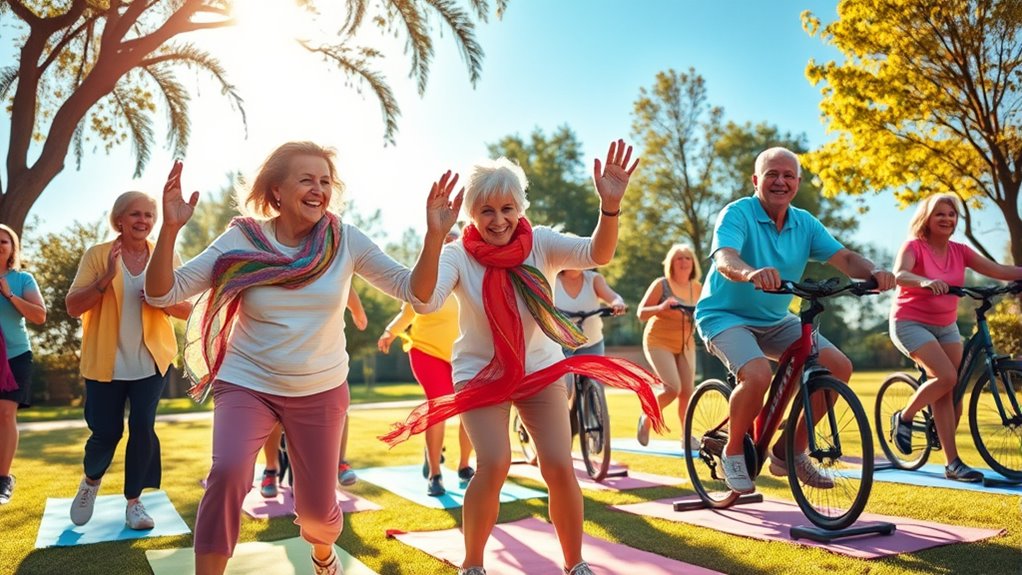
You can boost your heart health with fun low-impact cardio options like cycling or swimming that are easy on your joints. Additionally, engaging in these activities can be a great way to diversify your routine, much like how investing in precious metals can enhance your financial portfolio resilience. Joining a group exercise class not only keeps you motivated but also adds a social element that makes working out more enjoyable. These activities can enhance your fitness while reducing stress, leading to a happier, healthier you. Incorporating mindfulness practices into your routine can also help you stay focused and present during your workouts. Furthermore, understanding the importance of customer feedback can help you tailor your fitness activities to better suit your preferences and needs. Additionally, incorporating multi-functional gear into your routine can help maintain an active lifestyle while ensuring you are prepared for any unexpected situations. Remember, staying hydrated is crucial during exercise, much like how locating water sources is essential for survival in the wilderness.
Low-Impact Cardio Options
Low-impact cardio options offer a fantastic way for seniors to boost heart health while keeping joint stress to a minimum.
Here are some enjoyable activities you can try:
- Walking: A simple and effective way to elevate your heart rate without harsh impacts. Regular walking can also help improve overall fitness levels and endurance. This form of exercise may also enhance astrological compatibility as increased physical activity can positively influence mood and self-image. Incorporating digital creativity into your walking routine, such as using fitness apps, can make your experience even more engaging. Additionally, consistent walking can promote routine health checks to monitor overall well-being.
- Swimming: This low-impact exercise provides resistance while being gentle on your joints, making it perfect for seniors. The buoyancy of water can reduce the risk of injury while exercising. Participating in group swimming sessions can also foster a sense of community and support among seniors.
- Chair Exercises: Engage in seated marching or arm movements to stay active and improve cardiovascular health, especially if you have mobility issues. These exercises can be easily adapted to suit individual fitness levels and capabilities. Additionally, creating a fun environment with music or family involvement can make chair exercises more enjoyable.
Incorporating these fun activities into your routine can help you reach the recommended 150 minutes of moderate-intensity cardio weekly, enhancing your overall well-being while enjoying every moment. Additionally, staying hydrated and active is crucial for optimal heart health, especially for seniors.
Group Exercise Benefits
While participating in group exercise activities, seniors can experience a multitude of benefits that extend beyond just physical fitness. These fun cardio activities, like dance classes or walking clubs, boost not only heart health but also social interaction, essential for mental well-being. Additionally, engaging in eco-friendly travel can inspire a more active lifestyle by incorporating nature into physical activities. Moreover, maintaining involvement in children’s lives can contribute positively to emotional well-being and motivation for regular exercise. Adopting iterative processes in fitness routines can help seniors continuously improve their health outcomes. Engaging in imaginative play with children or peers can also enhance overall well-being and make exercise more enjoyable.
| Benefits | Description |
|---|---|
| Improved Motivation | You’re more likely to stick with exercise in a group. |
| Enhanced Coordination | Group workouts often involve varied movements. |
| Increased Enjoyment | Seniors report higher satisfaction from group activities. |
Engaging with peers encourages regular physical activity, reducing heart disease risks. Plus, the camaraderie makes maintaining a healthy lifestyle more enjoyable. So, grab a friend and immerse yourself in those group exercises! Additionally, positive affirmations can enhance motivation and support your fitness journey.
Strength Training: Building Endurance
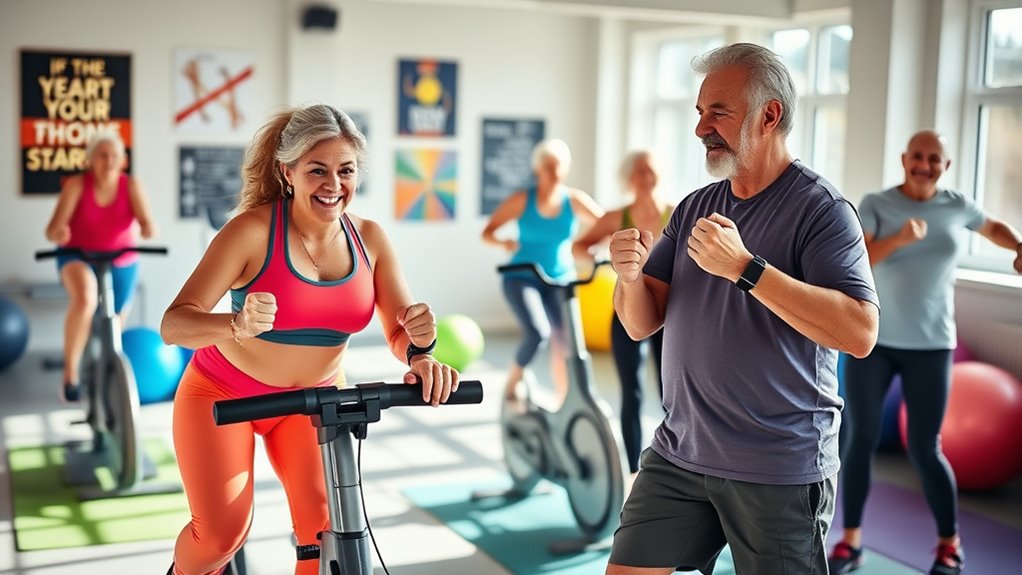
Strength training plays an essential role in building endurance as it enhances muscle mass and metabolism, which is important for seniors seeking to maintain their independence.
By incorporating strength training into your routine, you can enjoy several benefits:
- Improved Bone Density: Exercises like squats and arm presses strengthen bones, reducing the risk of osteoporosis and fractures.
- Chronic Condition Management: Regular strength training can help manage arthritis and diabetes by improving insulin sensitivity and reducing pain.
- Enhanced Mobility: Consistent strength training increases your endurance and mobility, leading to a better quality of life.
Engaging in resistance exercises weekly not only boosts your overall health but also supports your cardiovascular system by lowering blood pressure and improving cholesterol levels. Additionally, regular dental check-ups can play a crucial role in maintaining overall health, which is particularly important for seniors.
Recovery Techniques After Cardio
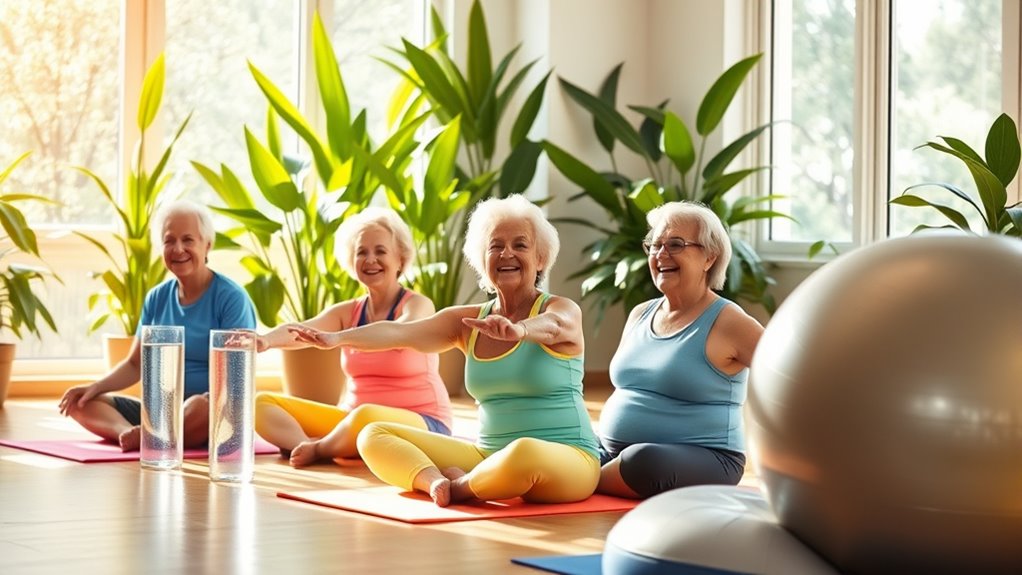
After your cardio workout, it’s essential to focus on hydration to help your body recover.
Drinking water or an electrolyte-rich beverage can replenish the fluids you lost while exercising.
Additionally, gentle stretching can alleviate muscle tension and enhance flexibility, making your recovery more effective.
Importance of Hydration
Staying properly hydrated is essential for seniors, especially during and after cardio workouts, as it helps maintain ideal blood circulation and regulates body temperature.
Dehydration can lead to fatigue and dizziness, so it’s vital to drink water consistently. Here are some hydration tips:
- Pre-Workout: Consume 17-20 ounces of water two hours before exercising to prepare your body.
- During Exercise: Drink 8 ounces of water every 20 minutes to keep your energy levels up.
- Post-Workout: Replenish lost fluids with water or electrolyte-rich beverages to support recovery.
Incorporating deep breathing exercises with your hydration routine can enhance relaxation and help your body recover more effectively.
Prioritize hydration to boost your overall health and performance!
Effective Stretching Techniques
Effective stretching techniques can play an essential role in your recovery after cardio workouts. They enhance flexibility, reduce muscle soreness, and promote quicker recovery, especially for seniors.
Incorporate deep breathing while you stretch to calm your body and improve oxygen flow to your muscles. Try gentle stretches like arm stretches or torso twists, holding each for 15-30 seconds to relax the muscles engaged during your workout.
Don’t forget to hydrate; drinking water while you stretch supports muscle recovery and prevents cramping. Regular post-cardio stretching not only improves your overall mobility but also reduces the risk of injury, contributing to better heart health and longevity.
Make stretching a priority for a healthier, more active lifestyle.
Staying Hydrated During Workouts
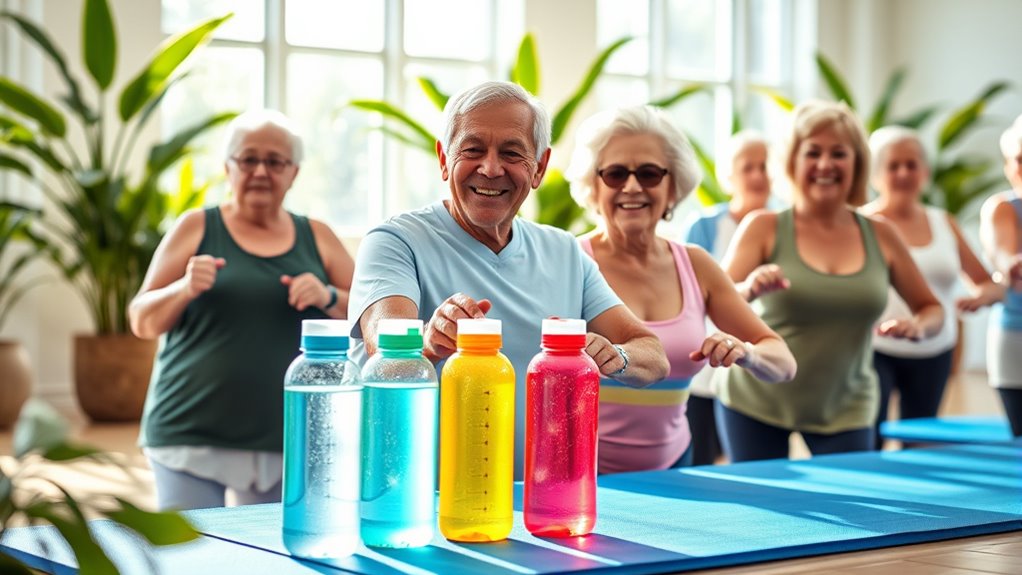
Hydration plays an essential role in your workout routine, especially as a senior. Staying hydrated helps regulate your body temperature, maintain joint lubrication, and prevent fatigue.
Staying hydrated is crucial for seniors, aiding in temperature regulation, joint lubrication, and fatigue prevention during workouts.
Here are some tips to keep you hydrated during your workouts:
- Drink water: Aim for at least 8 ounces of water 20-30 minutes before exercising. Continue sipping water during and after your workout.
- Monitor intake: Try to drink about half your body weight in ounces of water daily, particularly on active days.
- Include hydrating foods: Incorporate fruits and vegetables into your meals, as they can contribute to your overall hydration.
Creating a Consistent Workout Schedule
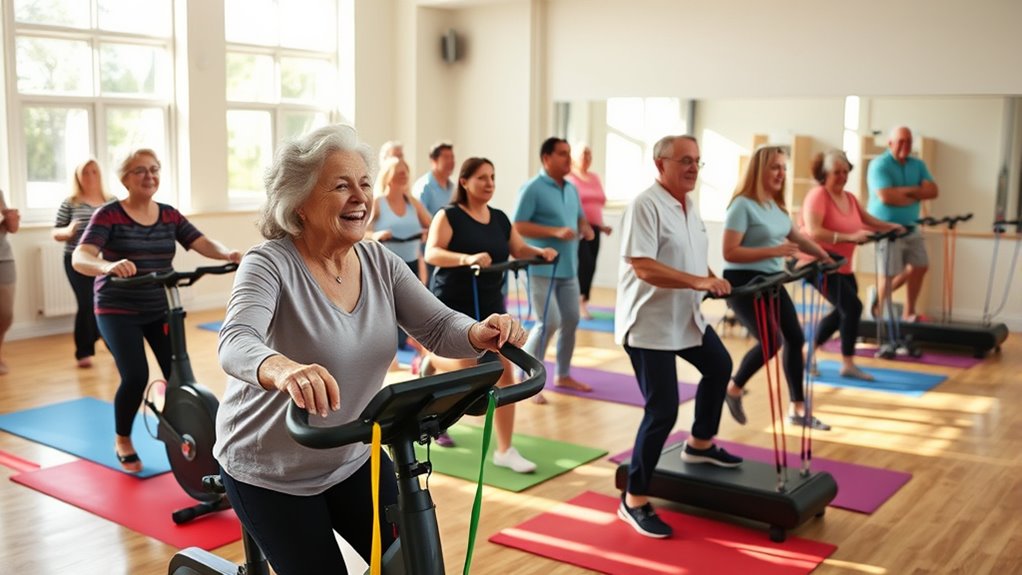
Creating a consistent workout schedule is essential for maintaining your fitness as a senior, especially since regular exercise can greatly enhance your overall health. Aim for at least 150 minutes of moderate aerobic activity each week, like brisk walking or swimming.
Incorporate strength training at least three days a week to target major muscle groups, boosting your heart health. Don’t forget to add flexibility and balance exercises two days a week to improve mobility and reduce fall risks.
Set specific days and times for your workouts, treating them as important appointments. This helps you stay accountable and consistent.
Finally, use a journal or fitness app to track your progress, keeping you motivated and allowing adjustments to your schedule as needed.
Tracking Your Progress and Achievements
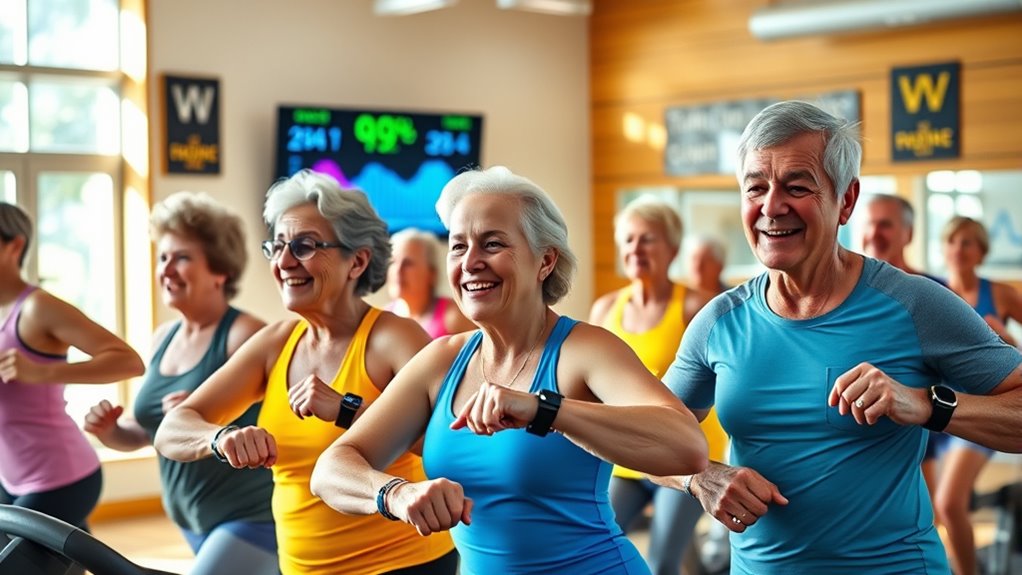
As you commence on your fitness journey, tracking your progress and achievements is essential for staying motivated and on course.
Here are three effective ways to monitor your improvements:
- Workout Journal: Document your workouts, noting duration, intensity, and frequency. This helps you see your progress over time and motivates you to achieve personal bests.
- Fitness Apps or Wearables: Utilize technology to track heart rate and calories burned in real-time. These tools provide valuable feedback on your cardiovascular fitness.
- Set Specific Goals: Establish measurable targets, like completing a certain number of steps daily or extending workout duration. Clear goals create a roadmap for your journey.
Regularly reviewing your progress will help you identify areas for improvement and adjust your workouts accordingly.
Tips for Staying Motivated and Engaged

Staying motivated and engaged in your cardio workouts can be challenging, especially as you navigate your fitness journey. To keep your spirits high, set achievable fitness goals, like completing a specific number of workouts each week. This sense of accomplishment can fuel your motivation.
Engage in social activities too; join a group class or exercise with a friend to make workouts enjoyable. Track your progress using a journal or fitness app to visualize improvements, reinforcing your commitment.
Incorporate variety by alternating between walking, swimming, or cycling to stave off boredom. Finally, celebrate milestones, big or small, by treating yourself to something enjoyable.
These strategies can help you maintain enthusiasm and stay committed to your heart health.
Frequently Asked Questions
What Is the Best Cardio for the Elderly?
The best cardio for you as an elderly individual includes low-impact activities like walking, swimming, and cycling.
These exercises keep your heart healthy while minimizing injury risk. You should aim for at least 150 minutes of moderate-intensity aerobic activity weekly.
Consider adding short bursts of higher intensity, like speed walking, to boost endurance.
Also, incorporating balance exercises like tai chi can help improve mobility and prevent falls, enhancing your overall fitness.
What Is the Simple Leg Move That Can Improve Your Heart Health?
Think of your heart as a garden; it thrives with regular care.
One simple leg move you can do is “marching in place.” As you lift your knees, you’re not just warming up; you’re watering that garden, boosting blood circulation, and increasing your heart rate.
This exercise prepares your body for more intense workouts while enhancing overall cardiovascular health.
What Is the Best Cardio Exercise for Your Heart?
The best cardio exercise for your heart is any activity that gets your blood pumping while being enjoyable.
You might try brisk walking, swimming, or cycling, as they’re low-impact and easy on your joints. Aim for at least 150 minutes of moderate-intensity exercise each week.
Mixing in activities like dancing or tai chi can boost your heart health while improving balance. Just find what you love, and make it a regular part of your routine!
Is 30 Minutes a Day of Cardio Enough?
Think of your heart as a car engine; it needs regular maintenance to run smoothly.
Yes, 30 minutes a day of cardio is enough to keep your heart healthy! Engaging in moderate-intensity activities like brisk walking, cycling, or swimming can greatly boost your cardiovascular health.
You’ll lower your blood pressure, improve cholesterol levels, and even enhance your mood. Just stay consistent, and you’ll reap the benefits of a healthier heart and increased energy!
Conclusion
Incorporating cardio into your routine isn’t just beneficial; it can be life-changing. Take, for example, Betty, an 80-year-old who started walking briskly for 30 minutes a day. Within months, she noticed improved energy levels and a stronger heart. By prioritizing your heart health, like Betty, you can relish life’s moments with more liveliness. So lace up your shoes, find an activity you love, and take that first step toward a healthier, happier you today!
